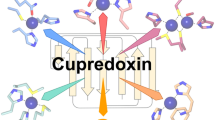Abstract.
Specialised copper sites have been recruited during evolution to provide long-range electron transfer reactivity and oxygen binding and activation in proteins destined to cope with oxygen reactivity in different organisms. Ceruloplasmin is an ancient multicopper oxidase evolved to insure a safe handling of oxygen in some metabolic pathways of vertebrates. The presently available knowledge of its structure provides a glimpse of its plasticity, revealing a multitude of binding sites that point to an elaborate mechanism of multifunctional activity. Ceruloplasmin represents an example of a 'moonlighting' protein that overcomes the one gene-one structure-one function concept to follow the changes of the organism in its physiological and pathological conditions.
Similar content being viewed by others
Author information
Authors and Affiliations
Additional information
Received 19 February 2002; received after revision 29 March 2002; accepted 2 April 2002
RID="*"
ID="*"Corresponding author.
Rights and permissions
About this article
Cite this article
Bielli, P., Calabrese, L. Structure to function relationships in ceruloplasmin: a 'moonlighting' protein. CMLS, Cell. Mol. Life Sci. 59, 1413–1427 (2002). https://doi.org/10.1007/s00018-002-8519-2
Issue Date:
DOI: https://doi.org/10.1007/s00018-002-8519-2




